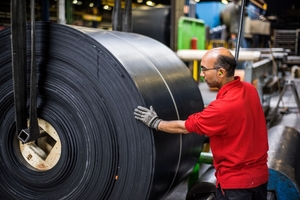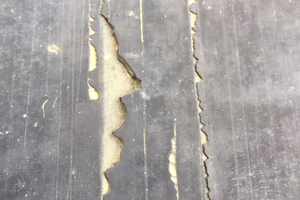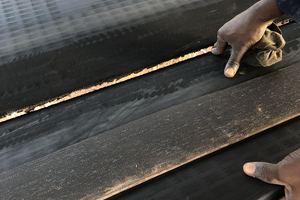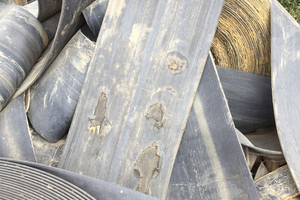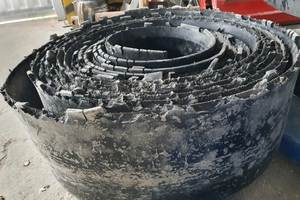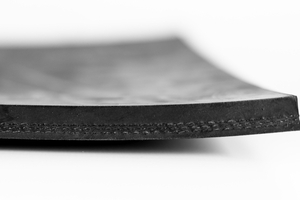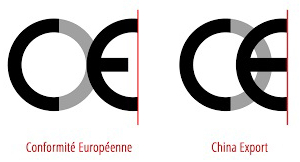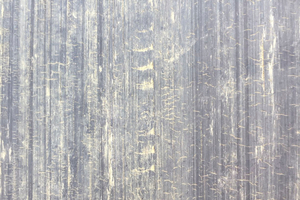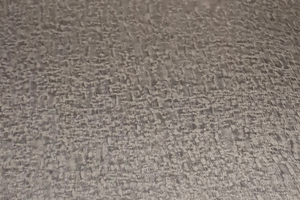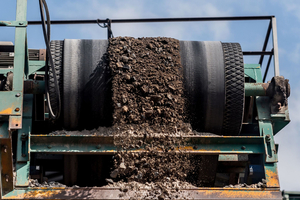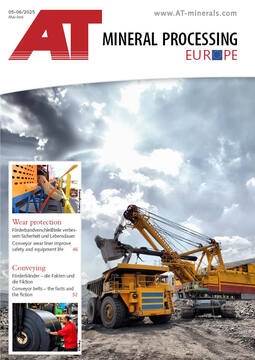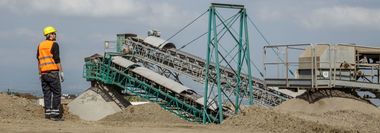Conveyor belts – the facts and the fiction
Probably the most common misconception concerning rubber industrial conveyor belts is that they are simply long lengths of thick, black rubber with very little to differentiate one from another. This is completely untrue of course, because they are a surprisingly complex and sensitive component. In the following contribution, Jeremy Clark reveals a long list of such misconceptions and separates the facts from the fiction.
The fiction: Thicker covers help to withstand rip, tear and impact much better.
The facts: It is the physical properties of the rubber rather than simply its thickness that has the biggest influence on the ability to withstand damage. The primary reason for surface damage is low grade rubber with an inadequate resistance to abrasive wear, ripping, cutting and gouging.
Much also depends on the overall strength of the rubber and its resistance to cut and tear propagation. Even in an extra thick cover, if the resistance to cuts and tears is insufficient then even a small area of damage can easily increase in size due to the continuous flexing around the drums and pulleys. This then spreads and links up with another area of damage causing small pieces of rubber to be cut out from the surface rather than being simply worn thinner.
The fiction: Increasing the tensile strength and/or increasing the number of plies improves rip, tear and impact resistance.
The facts: Increasing the tensile strength and/or adding more plies does NOT necessarily reduce the amount of damage, at least not significantly. The greatest influence on the strength and other essential physical properties needed to minimise damage is the design and quality of the ply material. Increasing the tensile strength and adding more plies can cause additional problems. Firstly, the belt becomes heavier and less flexible in both length and width. Reduced longitudinal flexibility normally necessitates an increase in the diameter of the drive pulley. Increasing tensile strength by just one step usually means an increase of 25 % or more. Failure to do so can lead to dynamic stress failure, especially in splice joint areas. Reduced horizontal flexibility causes a decrease in troughability.
The fiction: Steel cord belts can handle tough conditions better then multi-ply belts.
The facts: Replacing a multi-ply belt with a steel cord belt is rarely practical, highly expensive and very unlikely to succeed. Conveyors are specifically designed to accommodate steel cord belts. Because of their innate tensile strength and low elongation (stretch), steel cord belts are best suited to conveying long distances.
Although the steel cords are very strong, they cannot prevent a trapped foreign object from penetrating the covers between the cords and ripping the belt longitudinally; in fact, they are more likely to be completely destroyed by such an event.
The fiction: It is not worth the fitting good quality belts because they will get destroyed anyway and therefore be a waste of money.
The facts: “Sacrificial” belts are neither a good technical nor economical solution. The reason why a belt is prone to damage is that the rubber and the inner fabric plies are simply not designed for the task. The cheaper the belt then the more likely it will quickly fail. More frequent stoppages for repairs and change-outs make them even more uneconomic. The only genuine solution is to fit a conveyor belt that has been specifically engineered to withstand the kind of punishment that would destroy a normal belt. Despite the higher purchase price, they are definitely the most cost-effective solution by far because they use uniquely designed fabric plies that allow the weft strands to stretch.
As the belt is being pulled through the trapped object, the strands gather into a bundle that eventually becomes strong enough to stop the belt rather than propagate over a much longer distance. The design of the fabric weave also dissipates energy created by heavy impact over a much wider area.
The fiction: The step length of the splice depends on the width of the belt.
The facts: The step dimension for multi-ply splices depends on the strength of the individual fabric ply, nothing else.
The fiction: Improving the level of abrasion resistance by increasing the cover specification is the best way to solve premature wear.
The facts: The ability of rubber to withstand surface wear is not due to its “abrasion resistance” alone. Wear resistance is a combination of overall strength, resistance to abrasion and, very importantly, resistance to cut and tear propagation.
Increasing the cover specification may seem a logical solution to rapid wear but that is not necessarily the answer. One manufacturer’s DIN Y (ISO 14890 L) used for normal service conditions can often be more durable and more wear resistant than another manufacturer’s higher specification DIN X (ISO 14890 H) or even DIN W (ISO 14890 D), which are usually reserved for heavier-duty applications. Laboratory testing regularly exposes instances of belts claimed to be DIN X or DIN W that fail to even achieve the DIN Y standard. As with all forms of cover damage, the answer lies with the quality of the rubber.
The fiction: Conveyor belts can be made to be fireproof.
The facts: Not true. Rubber conveyor belts can never be totally fireproof. Rubber is flammable and the inner fabrics polyester and nylon plies have virtually no resistance to fire. Consequently, all belts will be damaged/destroyed by fire. However, rubber belts can be made with a varying degrees of fire resistance.
The ability to “resist” fire is achieved by adding special chemicals and additives to the rubber compound during the mixing process. Once vulcanised, the ignited rubber emits gases that effectively suffocate (self-extinguish) the fire by starving the flames of oxygen.
The fiction: Recurring splice joint failures is often a sign of insufficient tensile strength.
The facts: Lack of belt strength could be a cause, but it rarely is. Repeated splice joint failure is usually caused by either poor adhesion between the plies, cold rather than hot splicing and/or poor materials or workmanship. Increasing the tensile strength can reduce reliability rather than improve it. The strongest and most reliable splice joint method is the finger splice.
The fiction: Moulded belt edges are better than sealed edges.
The facts: Years ago, fully moulded edges were the standard because cotton was used as the reinforcing fabric in multi-ply belts. A moulded edge therefore prevented moisture penetrating the cotton fabric and causing it to rot. However, since the introduction of synthetic ply fabrics using polyester and polyamide, this problem effectively no longer exists. Contrary to popular belief, moulded edges do not provide any structural advantage and can be susceptible to damage if the belt wanders off-track for any reason.
Manufacturers such as Fenner Dunlop in the Netherlands automatically create sealed edges during the cutting to width process by using special cutting knives that rotate at an extremely high speed. The frictional heat created melts the carcass fibres and a small amount of the rubber on the edge of the belt, creating a very effective seal. Specifying moulded edges when not entirely necessary usually means that a belt has to be made to special order rather than supplied from stock, which increases the price and delivery lead time.
The fiction: The CE mark signifies that a conveyor belt is good quality.
The facts: CE accreditation does NOT apply to conveyor belts because they are not a product category that is subject to specific directives that are required to be CE marked. The letters “CE” are an abbreviation of French phrase “Conformité Européene”, which means “European Conformity”.
An almost identical mark is used by Chinese belt manufacturers so that potential users mistakenly believe it represents European conformity. In reality it actually stands for “China Export”, meaning that the product was manufactured in China.
The fiction: Resistance to ozone and UV is not essential apart from high altitude or sunny climate locations.
The facts: Contrary to popular belief, the damage caused by ozone (O3) and ultraviolet light (UV) is NOT limited to high altitudes or sunny climates. Ground level, “harmful” ozone, is created by the photolysis of nitrogen dioxide (NO2) from automobile exhaust and industrial discharges. The reaction is known as ozonolysis.
Tiny traces of ozone in the air attack the molecular structure of rubber. It increases the acidity of carbon black surfaces with natural rubber, polybutadiene, styrene-butadiene rubber and nitrile rubber being the most sensitive to degradation. The first signs are cracks that appear on the surface of the rubber. Further attacks occur inside the freshly exposed cracks, which continue to steadily grow until they complete a “circuit” and the product separates or fails.
Ultraviolet light from sunlight and fluorescent lighting also has a seriously detrimental effect because it accelerates rubber deterioration by producing photochemical reactions that promote the oxidation of the rubber surface resulting in a loss in mechanical strength. This is known as “UV degradation”. Damage from both ozone and ultraviolet is entirely preventable simply by the addition of antioxidants to the rubber compound mix. Despite this, some 90 % of belts fail within only 6 to 8 hours of the 96-hour EN ISO 1431 test. The reason for this is that the antioxidants needed are seen by most manufacturers to be an avoidable cost.
Conclusion
It is almost impossible to list all the misconceptions about conveyor belts because there are so many. However, an attempt has been made to address the most common misconceptions. If in doubt, it is always a good idea to speak directly to one of the manufacturers who are known for producing trustworthy quality.
Author:
Jeremy Clark, Conveyor belt specialist

